REBECCA RENNIE BIG BOARD 2022: SMALL SCHOOL TOP 75 (PAGE 3)
By Rebecca Rennie
The NFL Draft talent to be found at small schools from the FCS and beyond is strong every year, and 2022 is no different. This presents my Top 75 small school prospects for the 2022 NFL Draft. The project was challenging to put together this year, with time constraints and some life issues outside of football almost derailing any chance of completing this season’s big board. Thankfully, it was possible to pull this together in time for the event. It’s almost certain that there are plenty of names not included here that absolutely should be. Unfortunately, it was not possible to get to everyone’s film, so apologies if any personal favorites are missing!
Though expecting this to be more brief this year, ultimately we have around 23,000 words of content in this article over four pages. The Top 30 graded prospects have been written up in detail, 10 per page, with one bonus write up on an additional prospect, given he is a well known prospect and QB, but was not graded as highly here. The fourth page contains the full Top 75 big board as a list.
For the Top 30, a number grade has been included out of 100 that I have been using for a number of years. It is not formed as a sum of various parts for various traits, more so relating to a projected role for the NFL as starters, backups, developmental prospects and so on. They can be roughly correlated to a general round of the draft which is also given for some context.
There is a lot of content within this project and would be surprised if many intend to read this start to finish. However, whether used pre-draft or after your team has picked up one or more of these players during or after the draft, I hope this provides some useful information or reference.
21. Jared Brinkman, Defensive Line, Northern Iowa. Grade: 35 (7th Round)

Height: 6’0”. Weight: 292 lbs. Arm: 33”.
Pros: Though not featuring in many lists as a draftable prospect, Northern Iowa defensive lineman Jared Brinkman is getting that recognition here. The odds are admittedly in favor of not hearing his name called, yet there’s reasons to believe in the potential of finding a roster spot. His cause was aided by some notable marks at his recent pro day. He stood out on the bench in particular with 35 reps of 225lbs, better than any who attended the Combine this year. His 33.5” vertical jump would have led all defensive tackles in Indy as well.
The UNI defensive lineman features more of a short and stockier body type. While only a shade over 6’ tall, his 33” arms provide more than adequate length, combining with naturally good leverage. Similarly, at 292lbs, Brinkman is stout for his frame but not the heaviest for the interior. That said, as indicated by his bench total and from his work on film in the trenches, he offers impressive core power and impact to get results at the pro level. The Panthers D-lineman may not fly to the sidelines in pursuit but can surprise with impressive quickness out of his stance and short-area upfield burst.
Making use of leverage, he consistently raises anchors with a nasty bull rush. The resulting movement regularly breaks the pocket, leading to early backfield pressure. A good initial punch is followed by fast and aggressive hand use to work off contact. It is notable on film how often Brinkman draws double team attention. The additional blocking focus does not always shut down his efforts either. Brinkman often finds ways to disengage and split double teams at this level.
Making an impact against both the pass and run, the Panthers standout has a well-rounded skillset. Smartly executed rush plans are evident to set up and disengage at the point of attack. Patience and force are used in equal measure to position himself against the run. He offers inside-outside versatility to attack from different alignments across the defensive front. Speaking to his upper body technique and hand work, Brinkman was a state champion high school wrestler, as well as in shot-put.
Importantly, Brinkman played impressively in many of his most challenging matchups. Against Iowa State to open the season, the UNI defender worked Cyclone linemen backward with his power and deflected contact violently to disengage from blocks. He was also a constant menace in a hard-fought loss to North Dakota State during the regular season. Many performances saw disruptive play with statistical production going to his grateful teammates. Even with that in mind, Brinkman still compiled 73 tackles, 15 TFLs and 7 sacks, as well as a pass breakup and forced fumble in 2021. In a prior season’s appearance against Iowa, he achieved two sacks against the Big Ten Hawkeyes.
Cons: From a purely height-weight perspective, Brinkman would traditionally be considered slightly undersized. Teams could mark him down in that respect. Interior defensive linemen in the 290lb range are generally looked for to be dynamic and explosive interior rush types. Brinkman is not elite in this area when adjusted for size, though certainly solid in his athletic ability. He tested with a 5.16 dash (1.76 split) and 33.5” vertical among his recorded pro day numbers. His get-off is aided by timely reactions, drive out of his stance and his consistent motor.
Brinkman had some issues with his ankle during his sophomore year. The injury required surgery and rehab in the offseason. He has not appeared to show any lingering issues since but interested teams might be checking the medicals for potential long-term concerns. Factoring into his relatively lower profile as a prospect, Brinkman did not receive an opportunity to one of the more premium events in the lead-up to the draft. The Panthers DL was not rostered at the Senior, East-West Shrine or NFLPA bowls.
There was no Combine invite either. He did prove he could have held his own at the Combine though, with some of the previously listed testing. He was invited to the excellent and under-rated College Gridirom Showcase event, which has seen a good number of players go on to the pros in recent seasons.
Wrapping Up: While not a prominent name in this deep small school draft class, Brinkman could surprise if given the opportunity. His smaller frame is compensated by good length and outstanding power at the point of attack. He is quick off the snap and moves well between the tackles, bringing a high motor and toughness in the trenches. The Panthers lineman is impactful against both the pass and run, with discipline and positioning in the ground game, and under-rated disruptive capabilities to pressure the backfield. While it’s uncertain how much intrigue NFL teams have in Brinkman, he earns a draft grade here.
22. Nick Zakelj, Interior Offensive Line, Fordham. Grade: 33 (7th Round)
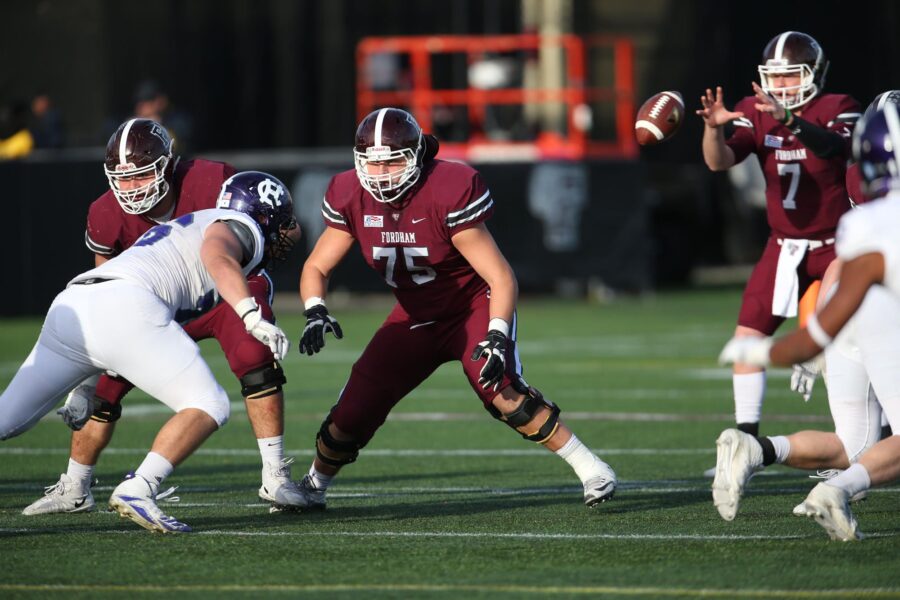
Height: 6’6”. Weight: 316 lbs. Arm: 32” 7/8.
Pros: In a deep, loaded FCS draft class this year, watching Missouri State D-lineman Eric Johnson battling in the trenches with Fordham’s Nick Zakelj on the Senior Bowl stage was fantastic to see and representative of the small school talent on offer. Similar to his defensive opponent on those reps, Zakelj’s game is build on toughness and aggression at the point of attack. That stood out months earlier in another key matchup for the Rams left tackle. Zakelj played up well to the higher competition level against Big Ten opposition against Nebraska in the 2021 season opener.
A college tackle, Zakelj’s measurables and strengths may lead to a better fit inside at guard. Often able to overpower and create backward movement against the Cornhuskers’ defensive line showcased the small school lineman at his best. Currently, he shows greatest effectiveness in his run blocking execution. Given his ability to hold up strength for strength against Power Five competition and again in Mobile during the All-Star circuit, he unsurprisingly dominates on film at the FCS level in that regard.
Zakelj is on the offensive in the opening phase out of his stance. He is quick to engage with a forceful punch, taking the initiative at the point of attack. He does so while remaining in control throughout each rep. Zakelj has excellent upper body technique with good hand placement. The core strength is complimented by controlled footwork, form and balance. The lower half execution results in reliable pass protection against most opponents he saw in regular season action. He rarely loses ground to maintain pocket integrity.
A four-year starter, Zakelj’s experience shows. Recognition and reactions are a plus in his game, rarely caught out of position or flat-footed. His blue-collar style and broad build bely the agility in his lateral movement, kick slide and overall foot quickness. Smoothly releasing from his stance, he tracks most outside rushes comfortably, keeping in contact round the arc. A late-stage shove is well-timed to create further distance and angle for rushers to turn the corner and delay pressure sufficiently.
Cons: Steady on film for the most part, there are occasional moments on film that raise concerns in pass protection. The feet and agility are generally good for his frame, yet he can be beaten by late-phase counters, inside moves and sharp hand use. Sustaining blocks is not currently consistent enough with rushers able to work off contact and beat Zakelj and breach the backfield. While the Nebraska contest had some outstanding highlights, the Rams lineman was also caught out on rush attempts a handful of times. Again, at the Senior Bowl, he had his ups-and-downs in practice reps and 1-on-1 drills.
Zakelj has a tall frame with good bulk for a potential pro tackle. His arm length is a little less than ideal for many team thresholds at a touch under 33”. This is far from drastically prohibitive, and the Fordham left tackle has ample experience on the edge. Depending on his landing spot, he could still get an opportunity to play outside. At the very least, his time at the tackle position could see him provide depth there in addition to the interior.
Though strong, as attested to by his solid 27 bench reps at the Scouting Combine, he can counteract this with his form. Zakelj can play a little too narrow and upright that leads to exploitable pad level. A variety of moves from bull rushes to speed-to-power moves can get into his chest, raise the anchor and work him off balance on occasion.
Wrapping Up: A favorite here for several seasons, Zakelj has been on the personal draft radar for some time. It was encouraging to see that reflected by the league in the build up to the draft. His invites to both the Senior Bowl and Scouting Combine bode well for interest on draft weekend. The pre-draft events have seen so many of the small schoolers excel and raise their profiles with practice performance and elite workouts. In truth, Zakelj’s pre-draft run has been a little more understated. There were some struggles at the Senior Bowl but with good flashes and certainly did not look out of place by any stretch.
His film shows off consistency, toughness, nastiness in his run blocking in particular, strength and a frame that can work at the next level. There are just enough questions though, that he could be waiting until the late stages before hearing his name called. Zakelj might project best as a backup early on with the potential to develop into a starter.
23. Jequez Ezzard, Wide Receiver, Sam Houston State. Grade: 33 (7th Round)
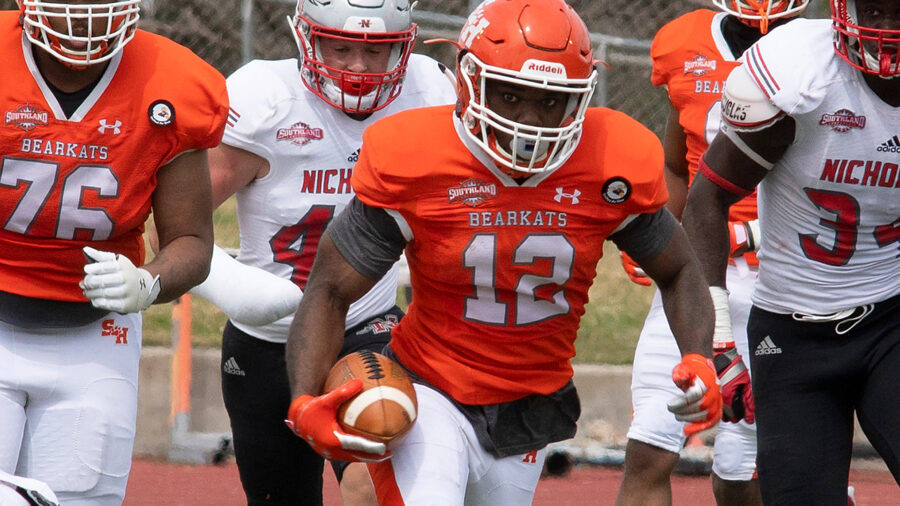
Height: 5’9”. Weight: 193 lbs. Arm: 30” 1/2. Hands: 9” 5/8.
Pros: Flash back to the summer, and Bearkats receiver Jequez Ezzard was widely considered one of the better FCS draft prospects for the 2022 cycle. Helping amplify his presence on the radar, Ezzard played a huge role in Sam Houston State winning a National Title during the shortened and rescheduled Spring Season. The transfer from Howard to SHSU was key in the title game with 10 receptions for 108 yards and 2 touchdown catches. His 2020/21 Spring led to being named All-American at two positions, at wide receiver (2nd team) and punt returner (1st team).
A constant big-play threat, Ezzard’s Spring season saw him take his 38 catches for over 22.6 yards per receptions and 9 scores in 10 games. In limited play time in 2021, he still contributed nearly 15 yards per catch on his 41 receptions, with 6 TDs. Healthy for the post-season, the Sam Houston pass catcher impressed at firstly the NFLPA Bowl, then in short time as a late call-up to the Senior Bowl. As expected, based on his film, Ezzard showed off lower body explosion at his pro day with a 37” vertical and 10’7 broad jump.
Several traits stand out early and often through the film. The frame is shorter, but Ezzard is densely built with a stocky, muscular physique. With that body type built lower to the ground, he utilizes that center of gravity with exceptional balance. He takes on contact, bounces off tackles and keeps his feet when running for maximum yardage.
Tied to that trait, Ezzard plays with sharp footwork in terms of efficiency and foot speed. There is a suddenness to his movements, minimal wasted motion to stop-and-start, plant-and-go, drive out of his breaks with acceleration. He capitalizes on the short-area quickness with an effective shake or rocker step to set up defensive backs before hitting the accelerators. It all adds up to excellent ability to create separation, exploit space, evade would-be tacklers and create impactful plays. The Bearkats standout excels with the ball in his hands after the catch, operating like a running back in the open field.
While able to separate frequently, Ezzard, should not be underestimated for his work in contested situations. He is often able to increase his otherwise limited catch radius with his effective vertical. Ezzard elevates well to high point, with the explosive pro day jumps translating to action on the field. With natural and instinctive ball skills, he times his extension well, rarely telegraphing his intentions early to the covering DB. The dynamic athlete can offer added versatility with his returner skills on special teams.
Cons: The timing at which Ezzard’s draft stock was at its peak has not been the most opportune. His prominence during Sam Houston’s playoff success in the Spring was too late for the 2021 draft cycle. Though that led to intrigue over the Summer, some misfortune has partially derailed his momentum since then. Ezzard appeared in 10 games during this past season but was hampered with a lingering injury. Several games saw a lesser snap count, impact and production than he otherwise would have provided. The former Howard receiver also missed the 2019 season due to injury prior to switching to SHSU.
Several other factors might be considered as slightly unfavorable, even though not overly detrimental to his stock. The FCS prospect will be older than most, playing six seasons in college. Ezzard has a frame more fitting to the interior over the middle of the field. His excellent vertical abilities should never be discounted but has a smaller frame that may not see him often deployed outside in the pros. As fantastic as he is with the ball in his hands and with his effective sudden changes of direction, the precision of his routes can be a bit more consistent than currently. Some further work to fine-tune his route execution should only add to his abilities to win.
Wrapping Up: A banged-up final season was unfortunate, but that should not detract from a skill set which can succeed in the pros. Ezzard is creative after the catch and elusive in space. While the target window is smaller, his ability to separate and work open is appealing for work over the middle of the field. Ideal balance, footwork and burst will apply both on offense and potentially on special teams as a returner. It’s difficult to envision a late-round selection not returning on value, should he be drafted.
24. Christian Benford, Cornerback, Villanova. Grade: 31 (7th-HPFA)
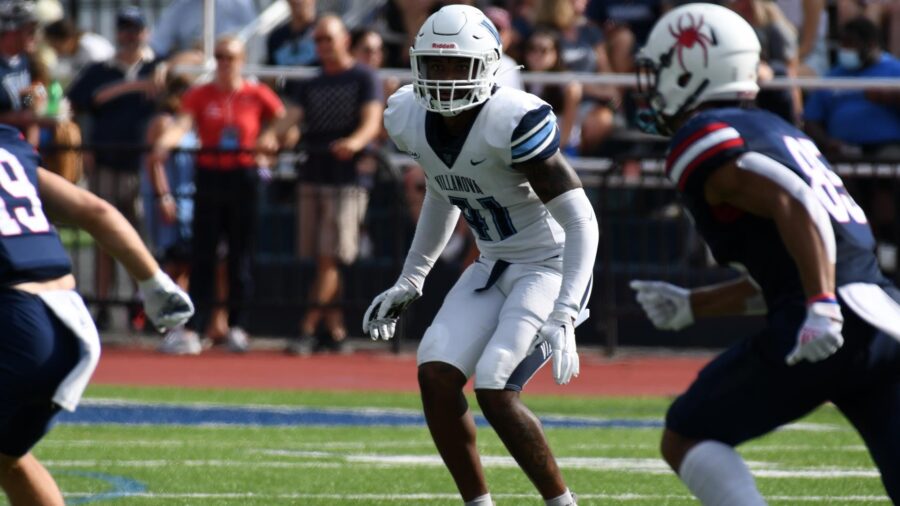
Height: 6’0”. Weight: 208 lbs. Arm: 31”.
Pros: When considering some of the tangible traits to check off at cornerback, Benford hits on the vast majority of them. So much so that he has plenty potential to procure a late round draft selection, despite his relatively low profile over the course of the pre-draft cycle. The Villanova DB is a well-rounded athlete with size and strength, and eye-opening statistical ball production. An NFLPA Bowl participant, he was not invited to the Combine. However, he drew some deserved attention at his pro day and is receiving his share of team visits in the closing stages leading up to the draft.
Though perhaps not elite in any singular measurable, nor is Benford lacking in any area. At over 6’ tall, his frame is well filled out with a build not unlike a safety, including solid length in his 31” arms. At his pro day, the Wildcats defensive back was crisp through his testing drills. A 4.53 dash (1.51 split), 35” vertical, 10’4 broad, 4.34 short shuttle and 7.10 three-cone were among his results. Reflecting his toned build and play strength, Benford’s 17 bench reps would have ranked tied-2nd among Combine corners in 2022. The vertical would have ranked 7th in Indy and the broad jump 6th.
Benford’s impact with his ball skills is undeniable. The knack for turnovers tracks back to his high school days in which he totalled 17 career picks at that level. That has only continued in college, with 14 interceptions and 33 pass breakups over four seasons. That culminated with his 2021 final season of 18 PBUs and 7 picks. Benford attacks the ball in the air, fights receivers for position and often makes dynamic late deflection after recovering from a trailing position. If he can continue to make plays on the ball as a pro, he could quickly outperform his draft spot.
A smooth athlete for a more muscular corner, the Villanova DB works laterally with fluid movement, backpedals comfortably and turns to run with efficient hips. His film impressed with the sudden feet and sharp changes of direction. Helped by minimal wasted motion, Benford is capable of keeping tight and in phase as receivers break at the top of routes. It may be related to scheme, but Benford doesn’t often get his hands on receivers at the moment of release when playing up at the line of scrimmage. However, when battling over the course of routes at the catch point, the Wildcats corner is aggressive with his upper body technique, tough to shake and competitive at the catch point.
Cons: Benford’s film has its share of frustrating inconsistencies. Though very competent at his best with keeping close in man coverage, there are a share of more poorly executed reps. The reactions and quick feet are positives but there are tendencies to position himself unfavorably relative to the receiver. The results can be some easily surrendered completions. Polished route runners will be able to exploit this more frequently in the pros.
At times, Benford can get lax in his focus, in which he will drift from his coverage assignment to allow some easy separation. Combined with occasion late responses at the top of routes, he can fall a step behind. It was referenced earlier that the Villanova corner can make a play on the ball late. The tendency to be working form a trailing position will not be tricky to recover from at the pro level as in the FCS. Though far from slow, his speed is not quite at the level where he can close gaps as readily in the NFL.
Wrapping Up: The number of small school defensive backs in this class that have Day 3 draft potential is fascinating. It seems inevitable that a handful will go unselected. Benford’s odds seem good to find a spot in the later rounds, with plenty in his favor. With his frame, movement and production, he not only has a lot to trust in, but a good ceiling should he maximize his abilities. There are some technical improvements to sharpen up and some consistency questions, but good base traits as the infrastructure to build upon.
25. Dennis Houston, Wide Receiver, Western Illinois. Grade: 30 (7th-HPFA)
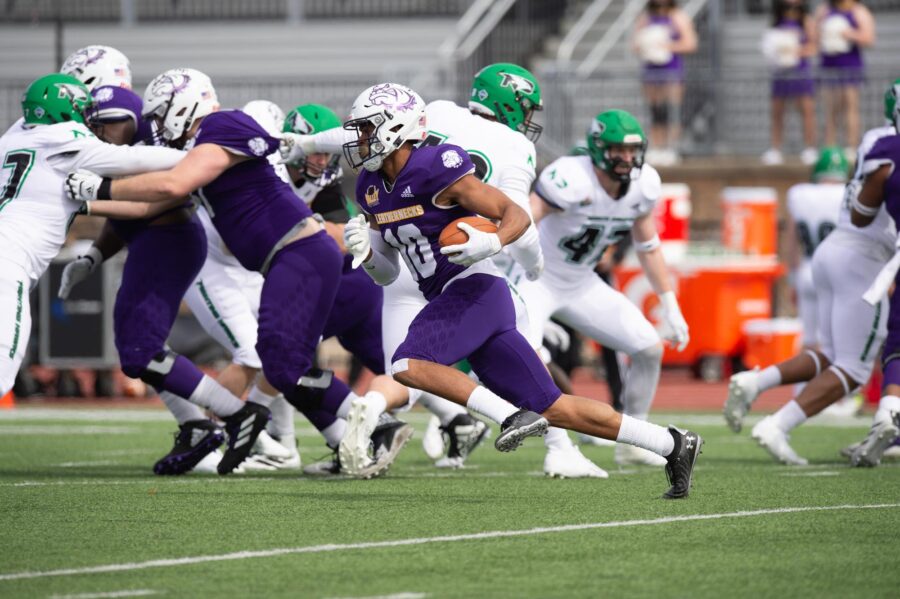
Height: 6’1”. Weight: 198 lbs. Arm: 31” 5/8. Hands: 8” 5/8.
Pros: Wide receiver is one of the more talented position groups among FCS prospects for 2022. As a result, several outside the likes of Watson and Weston with pro potential are going under-the-radar. Count Western Illinois’ Dennis Houston among that group, not helped by the Leathernecks finishing 2-9 on the season. Despite the team’s overall struggles, Houston piled up 90 catches for 1,015 yards and 6 receiving touchdowns. The versatile threat added a further two rushing touchdowns.
While the losses added up, Western Illinois were respectable in a 31-21 loss to FBS opponents Ball State to open the season. In the most high-profile matchup of the season, Houston took advantage with a huge performance. A 75-yard catch-and-run touchdown was the highlight as he compiled 12 catches for 237 yards (19.8 average) and 2 scores.
A couple big gains padded the stat sheet, but much of the encouragement that came from the performance was based around some of the more routine receptions executed around those highlight moments. The safe hands over the middle while taking a hit. The chain-moving underneath and intermediate plays. High pointing and taking ownership at the catch point on sideline grabs. Fighting for extra yards after contact, breaking tackles and off-ball blocking. Overall, the well-rounded game on display suggested a potentially translatable game for the next level.
The Western Illinois playmaker isn’t the biggest target but looks the part with a muscular well-built frame. Notable throughout his 2021 film is the impressive releases and acceleration off the line. Though not a true blazer, Houston is a good athlete with burst, good feet and smooth movement. Maintaining his speed while breaking his routes aid in separating from coverage. The overall physical attributes contribute towards the ability to be a factor short and over the middle, in addition to deeper shots downfield.
At Northwestern’s pro day, Houston confirmed that he had enough athletic potential to hold up at the NFL level. He ran a hand-timed 4.49 dash, a 4.35 shuttle and 7.17 three-cone. Most impressive was the explosion indicated by his jumps, with a 39” vertical and 10’4” in the broad. His physical style of play was complimented by 19 reps on the bench.
Speaking to his physicality, Houston plays with an alpha mentality. This is evident in how he takes ownership of his route paths, makes himself difficult to disrupt off his intended movements, and in challenging at the catch point. He uses his hands well from press coverage and brings it as a blocker off the ball. He combines toughness with focus when catching in traffic and taking a hit.
Cons: Hopefully, Houston’s pro day will be a catalyst toward a free agent signing, or even an outside chance at a late-round draft selection. It may be a longshot, however. Houston was not among the list of FCS prospects extended a Scouting Combine invite. Prior to that, the Leathernecks receiver was not afforded the opportunity at one of the higher profile All-star events. He did attend the College Gridiron Showcase However. The CGS is an under-rated event that has featured some outstanding talents in recent years that have been drafted and/or rostered in the NFL.
Houston measured in slightly smaller than expected. As with many or most colleges, the numbers tend to be somewhat inflated. Listed at 205 lbs by the team, the small school receiver weighed in a touch under 200 l bs. The hand measurement may concern some teams, with relatively smaller 8’ 5/8 hands. We apply the very reasonable cliché though of “it’s not a problem until it’s a problem”. All indications on film are that it’s not a problem. Houston does not have the most extensive catch radius but is reliable at the catch point.
Wrapping Up: The Leathernecks were not the best of teams in 2021, but in Houston’s favor was the schedule. Playing in one of the more prominent conferences in the FCS, the WIU playmaker was productive against strong opposition in the Missouri Valley Conference, in addition to the Ball State contest. Houston has translatable burst, toughness, polished technique and a well-rounded skillset. What stands out in his game is his impact on all levels and areas of the field. He shows up on shorter targets, deeper downfield, out wide or over the middle. He found success with backfield hand offs to add to his threat. Going undrafted feels like the more likely outcome, but personally see a player with a good enough floor to round out a receiver room with the right opportunity.
26. Brayden Thomas, Edge Defender, North Dakota State. Grade: 29 (7th-HPFA)
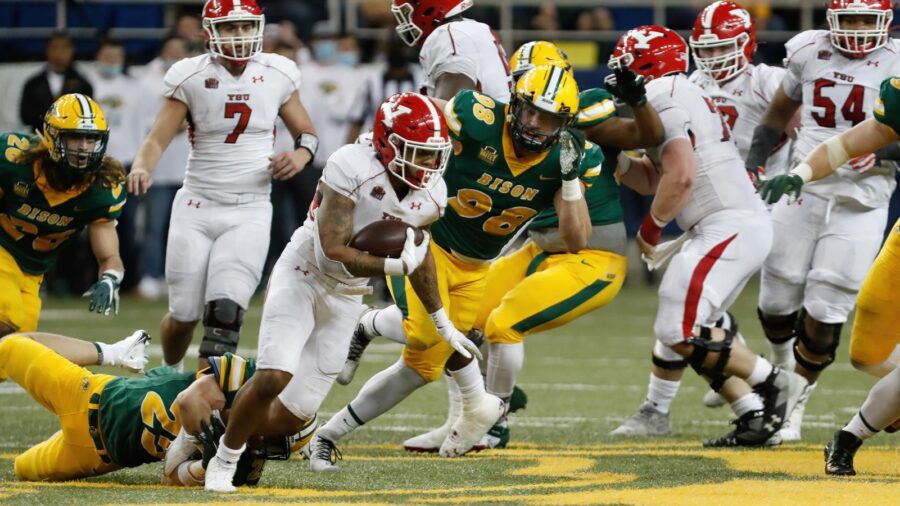
Height: 6’3”. Weight: 258 lbs. Arm: 32”. Hands: 9” 3/4.
Pros: Of all prospects in this class, the most consumed game films watched might have been invested in Brayden Thomas. He proved an interesting study and one whose appeal grew with more viewing. A transfer to NDSU, the viewed snap count was also bumped up by taking in footage of his time at D2 Minnesota State Mankato. With almost all snaps with the Bison spent at left defensive end from a 3-point stance, it was worth seeing if there was more variety in his deployment at his previous stop. LDE remained his near-exclusive alignment with a rare swap to the right side noted occasionally.
Thomas was a relatively late announced addition to the Shrine Bowl event. Generally considered the second most prominent All-Star event, it’s hopefully an indicator of some pro interest, even though Thomas was unfortunately not invited to the Combine. During the Shrine game, the NDSU edge factored in an opening 3-and-out with a pair of pressures in the first series. He continued to show good strength at the point of attack and working off contact as part of effective overall run defense during the contest. Speaking of strength, one of Thomas’ better pro day testing marks came in the bench, with 25 reps.
Thomas has a stout frame with enough arm length at 32”. Many of his rush attempts involve straight-line attacks into the body, seeking out early contact, delivering the first punch and working to disengage. While direct attacks are frequent, the more watched, the more evidence emerged of better bend and flexibility than first expected. While not at an elite level, Thomas can get low and turn the corner to offer a threat outside. His pro day cone time of 6.90 was a notable mark set. He brings a relatively lower center of gravity and enough power to create some advantageous leverage. Building on that setup, Thomas shows the ability to work the outside shoulder and soften angles en route to backfield takedowns.
The physical traits in terms of size and athleticism are limited but he uses intelligent and defined rush plans alongside a high motor and overall toughness in the trenches to aid his ability to create pressure. He turned that into solid numbers, including 14.5 tackles for loss and 9 sacks in 2021. Taking into account the heavy rotation employed by NDSU, those numbers reflected his ratio of impactful rushes. While his tackle stats with the Bison were modest, the film shows Thomas setting an effective edge, good positioning and the motor to chase down to the edges.
Cons: The overall measurables could hurt Thomas’ chances of being drafted. Following no Combine invite, the focus turned to the North Dakota State pro day to reveal the athletic profile. He did set good marks in the 3-cone drill and bench, but other testing was less encouraging. Thomas’ dash time of 4.92 (1.69 split) wasn’t ideal. His jumps were not overly explosive either, with 32” in the vertical and 9-3 in the broad jump.
The positive aspects of how Thomas wins are detailed above, and the small school edge is no slouch in his movement, helped by the hustle he plays with. The underwhelming athletic measurables do appear to match up with the film, however. He doesn’t appear to play with notable explosion and dynamic agility. He can find a role in the pros but there are limitations to his projectable upside and resultingly, his relative draft stock. In an NFL where versatility is increasingly valued, Thomas may be able to do more but hasn’t shown much varied utility on film.
Wrapping Up: Some of the pro day numbers may have been below-average for his size profile but shouldn’t be overblown. He is more than sufficiently athletic, with the cone time reflecting his ability to move and film that shows how he wins. Thomas is as tough as they come, with a physical game and relentless motor. He plays with intelligence, power and leverage, while surprising with his bend around the outside. He knows how to shorten and soften angles, how to work off contact and unbalance opposing linemen. The ceiling may not be as high as other small school prospects but personally believe he can offer a depth and rotational role. He could surprise in camp in the right situation.
27. Dai'Jean Dixon, Wide Receiver, Nicholls. Grade: 29 (7th-HPFA)
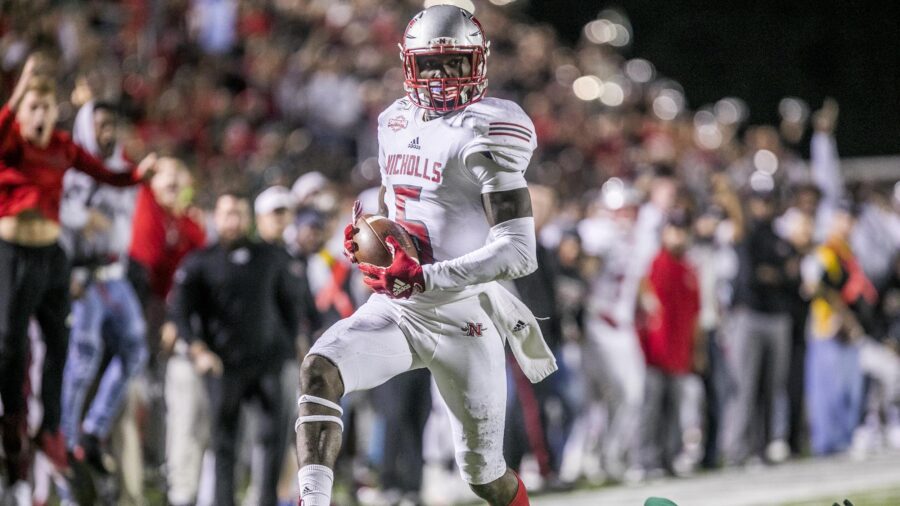
Height: 6’3”. Weight: 205 lbs. Arm: 33”. Hands: 9” 3/4.
Pros: Invited to the Combine during the previous draft cycle, Dixon ended up playing in the FCS Spring season and ultimately playing one final year during the fall. He earned that initial invite to Indy following a highly productive 2019 season. That year included over 1,000 receiving yards at over 19 yards per catch and 8 touchdowns. The Colonels receiver again surpassed 1,000 yards in 2021 at over 14 yards a reception with a further 8 scores. In a key opportunity against FBS opponents Louisiana, Dixon had his most productive outing of the season. Against the Cajuns, he totalled 14 catches for 198 yards and 2 TDs.
In the Louisiana contest and throughout the last few seasons, his QB has clearly looked to Dixon often. Very evident this year was how often Lindsey Scott Jr. went to Dixon on third down specifically. That did not mean that the Cajuns or Southland conference opponents could do much to stop it, converting at an impressive rate. His impact is felt at every level of the field on deep sideline targets to underneath completions and yards-after-catch runs.
Dixon features such a deceptively languid style that belies his timing and route-running. His ability to find space in zones and work open between defenders on film is at times masterful. Dixon demonstrates impressive spatial awareness as he navigates space and sets up coverage. He shows excellent subtlety and timing as he sells his routes. There’s natural savvy in working through traffic over the middle of the field.
Dixon features good length on a lean frame, including nearly 32.5” arms. Though not a dynamic athlete, the Colonels receiver is a smooth mover. Often a deep target for Nicholls, Dixon has the stride length to cover ground fairly well down the field at the FCS level. He finds success on contested catches through good concentration at the catch point. Maximizing his length on vertical jumps compliments his favorable catch radius to target. The hands are generally reliable, high pointing well and able to secure the ball away from his body.
Cons: Though a smooth athlete, Dixon doesn’t appear overly dynamic or explosive with solid but modest top end play speed. That played out in his testing with a slightly underwhelming 4.62 dash at the Combine. The physicality and strength are ok but wouldn’t say he truly owns the catch point consistently. That said, he puts in a shift as a blocker and has his share of highlight catches under tight coverage. He has the hands to catch clean with extension but is not averse to favoring a body catch when the opportunity is there.
While a sexual assault charge was recanted, NFL teams will still do their due diligence on the incident back when Dixon was 17. They should receive positive referrals from the likes of his high school coach, who at the time talked about how little sense the accusation made relative to Dixon’s character. That all said, Dixon also has an August 2019 arrest to investigate, following a speeding traffic stop. He faced an alleged possession with intent to distribute marijuana charge. He also admitted to smoking weed and drinking alcohol prior to the traffic stop.
Wrapping Up: While his length and frame stand out at the FCS level, he might blend in a little more among NFL talent. There arguably are not “wow” traits among his skill set to offer a significant ceiling. The impressive feel as a route runner, fluid movement and an accommodating catch window to target are positives. Modest burst and physicality are questions and potential limitations. He has the rare circumstance of having been invited to the Combine twice that suggests the NFL interest is there. He feels like a late-round selection but could potentially end up a free agent pickup.
28. Sam Webb, Cornerback, Missouri Western. Grade: 29 (7th-HPFA)
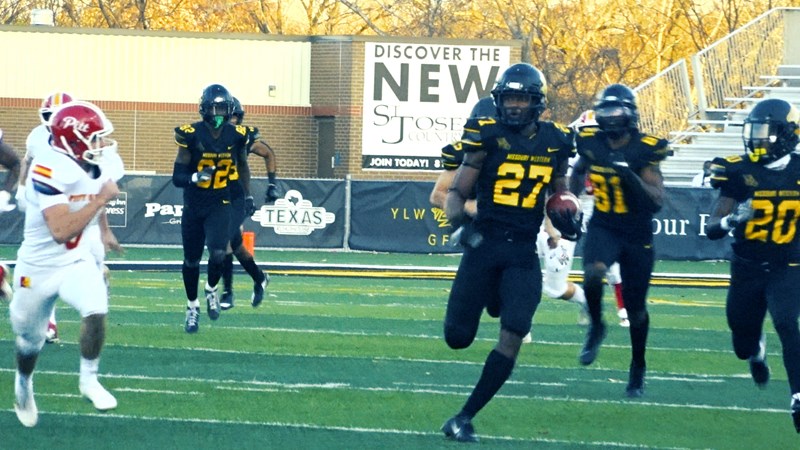
Height: 6’1”. Weight: 201 lbs. Arm: 32” 1/8.
Pros: The step up from Division 2 will be steep but Webb has been firmly on the NFL Draft radar for the physical developmental traits he has to work with. A Hula Bowl and East-West Shrine invite preceded a workout at the Scouting Combine. Webb’s testing matched with expectation for a height-weight-speed toolsy corner prospect. At his good size, Webb ran a 4.48 dash (1.57 split) in Indy with 14 reps on the bench. At his pro day, he added eye-opening jumps of 42.5” in the vertical and 11’4 in the broad jump. His short area quickness translated to a 4.18 shuttle and 6.94 three-cone time.
The impressive frame stands out on film, with length and a toned, muscular build. There is clearly easy movement and fluidity at that size of 6’1” and over 200 lbs. He shows quick feet in his backpedal, loose hips as he turns and overall comfort in his changes of direction as he works backward and laterally. The quick burst of acceleration is joined by the speed to stay in phase tracking deeper routes.
Though he can improve as a tackler when in position, there’s a tenacity to Webb’s play. There are flashes of the physical corner shedding blocks with the aggression of a linebacker. He will get hands on a receiver early off the line of scrimmage and stays unwaveringly contentious when battling receivers in tight coverage and as the ball arrives. Webb asserts himself at though he is the intended receiver at the catch point, looking to own the catch point much as an offensive playmaker might. His ridiculous vertical leap proves advantageous in jump ball opportunities.
Cons: The positive aspects to Webb’s physicality were cited previously. There are also some negative considerations involved. The D2 prospect draws penalties and risks interference with his play. What tends to let him down is not the intent but the execution. There is a rawness to game and in his technique, currently. There is a tendency to grab and hold, and to be poor with the timing of his hands. The overall execution is very clumsy and undisciplined.
Webb can also look raw in his positioning relative to the receiver over the course of routes, that can leave him working from a detrimental starting point. He will require to clean that up and sharpen his all-round game at the next level. His physical and athletic advantages over the majority of opposition faced won’t carry to the same extent in the pros. Webb’s contributions to run defense are a work-in-progress also. His set up in space and his finishing when in positions can improve to match with his frame and presence.
Wrapping Up: It would not surprise to see Webb drafted on Day 3 based solely on the traits. Given his size, length, sturdy frame, his speed and vertical explosiveness, the tools are all present to entice on untapping the potential upside. That alone would justify a late-stage draft investment. It cannot be overstated however, that Webb is very much a project. His recognition and anticipation, his technical application and his predominantly raw game in general will need to take significant growth in order to reach his potential. A contributor on special teams in college, applying his impressive physical abilities in that area will be a good way to contribute early on.
29. Noah Elliss, Defensive Line, Idaho. Grade: 28 (HPFA)
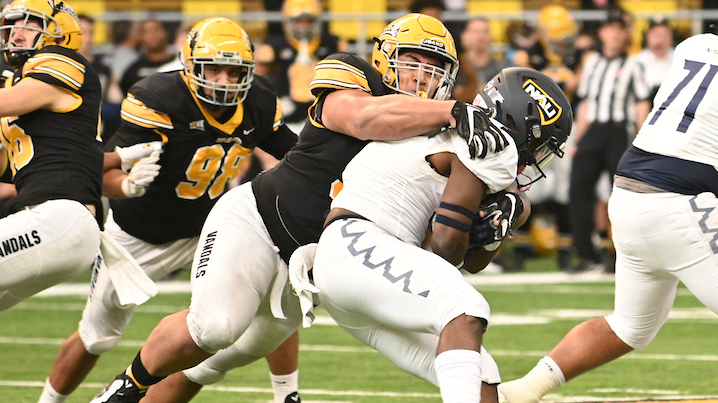
Height: 6’4”. Weight: 351 lbs. Arm: 32” 1/4.
Pros: While relatively low-profile players, the Vandals have produced a number of NFL pros in recent seasons, particularly on the defensive side of the ball. Two Elliss brothers, Kaden and Christian, have been among the latest additions to the league, and a couple more Idaho prospects could soon join them, including a third Elliss sibling. Linebacker Tre Walker is an under-rated small schooler for 2022, while defensive lineman Noah Elliss has enjoyed a promising pre-draft process. Encouraging for his NFL chances, Elliss was an invite to the East-West Shrine event, followed by the Scouting Combine in Indianapolis.
East-West Shrine practices saw Elliss receive his share of praise for his power, work at the point of attack and gap control. The stoutly built lineman may not be a standout athlete, yet gets impressively low in his pre-snap stance. He is able to fire out from a low release, deliver an impactful opening upward punch, raise anchors and work the opposition backward. The leverage advantage created features in many of his best reps. The projected nose tackle shows more flexibility than expected with lower body explosion in short bursts.
When the hand placement is on point, Elliss routinely overwhelms FCS opposition. Unsurprisingly, the Vandals defender saw frequent double team attention, yet still proved challenging to contain. He flashed examples of splitting double teams, driving gaps, and creating backfield pressure and disruption. Finishing plays tended to be handled more by grateful teammates, but still put up solid numbers in 2021. Elliss totalled 46 tackles with 6.5 TFLs, 1 sack and 3 pass breakups.
More than just brute strength, Elliss demonstrates good recognition and timing when working off contact, disengaging and positioning himself for run stops. His ability to consume space, draw blockers and engulf linemen makes for often enjoyable film to review. When in position, ball carriers are forcefully taken to the turf. Though finding his footing in Idaho, Elliss was initially a 4-star recruit, originally signing with Mississippi State, ultimately unable to play for the Bulldogs due to academic eligibility. In addition to his brothers in the league, Elliss’ football bloodlines include his Uncle, who was a first round pick of Detroit in 1995.
Cons: There are movement constraints to Elliss’ athletic profile. His Combine dash of 5.62 (1.85 split) was the slowest at his position group this year. At his build and projected deployment though, his game won’t involve sprinting long distances in order to execute his assignments. Still, Elliss won’t chase down many ball carriers beyond the line of scrimmage and to the sidelines. He is limited when requiring to redirect. In a league valuing interior pass rush pressure, Elliss is unlikely to provide a great deal in this aspect.
There were a couple films in which Elliss started hot but showed less burst as the game progressed. His good plays were interspersed with some more lethargic reps. There was a tendency to stand up higher out of his stance with increased snaps. Rising pad level and loss of leverage reduced some impact at the point of attack. Technique and form overall shows inconsistency, including with hand placement that gets too wide too often. While he has size in terms of height and weight, his arms are of more modest length than ideal.
Wrapping Up: Elliss may not be the dynamic playmaking interior rusher type but has a very easily projectable role for the pro level. The Vandals prospect can be a force against the run playing nose tackle in a 3-man front. Though his build isn’t the most defined, Elliss has the bulk and strength to replicate his gap controlling, space eating impact at the pro level. However, conditioning is a question, as is his form, upper and lower body technique. The physical limitations with his movement, quickness and length factor into minimal impact in the backfield. The pre-draft process could aid in a Day 3 selection but going undrafted remains a possibility also.
30. Julius Chestnut, Running Back, Sacred Heart. Grade: 28 (HPFA)
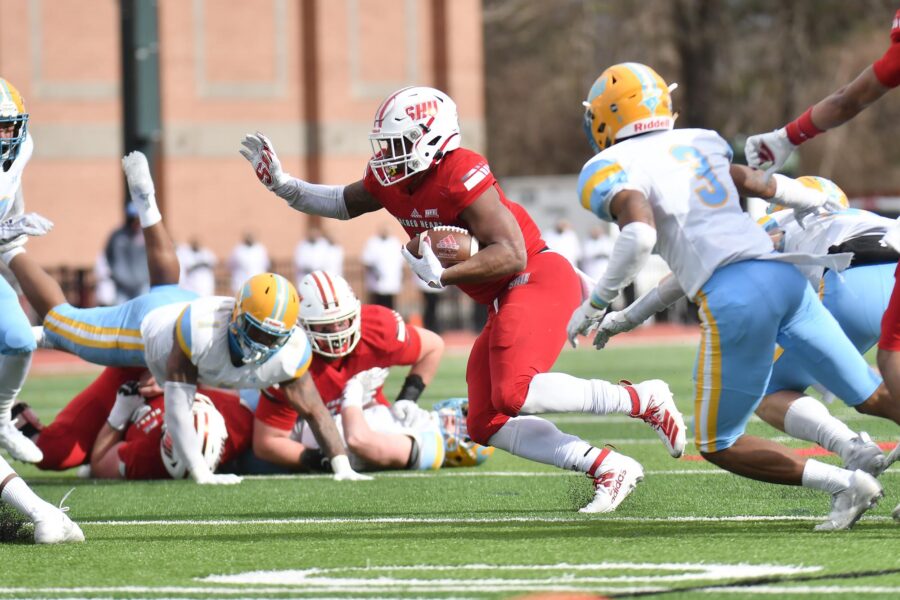
Height: 5’11”. Weight: 228 lbs. Arm: 29” 1/4. Hands: 9” 1/8.
Pros: Small school prospects can go under-the-radar at even the most successful FCS teams. That can be the case even more so for prospects from relatively lower tier FCS conferences. Despite an outstanding career at Sacred Heart, running back Julius Chestnut is likely still not very well known by a sizable portion of those following the NFL Draft. His name would have received more renown following a positive appearance at the NFLPA Bowl. Showing off a combination of strength and better-than-expected agility at that event among good quality talent ought to have elevated his standing with many.
Chestnut has dominated during his time in the Northeast Conference. The Pioneers runner has put up prolific numbers throughout college. Rushing for over 6 yards-per-carry as a freshman earned him a finalist spot for the Jerry Rice Award. His sophomore season only built on the early success with nearly 1,500 rush yards and 13 total TDs. Chestnut ran for a ridiculous 717 yards in just 4 games in the shortened 2020/21 Spring season, earning 1st team All-American recognition. Despite injuries limiting his final year this fall, the SHU back achieved just shy of 6 YPC over his five games, excelling when available.
That statistical output has potential to see Chestnut continue to find success as a pro, in part due to some positive measurables. Much like a couple other recent successful small school ball carriers such as James Robinson, Chestnut has a well-built frame to hold up at the next level. In terms of height and weight, Chestnut is impressive at close to 230lbs at 5’11”. How he moves at that size is intriguing. Some contrasting times have been reported, including in the low 4.6s, but also with dash times recorded in the high 4.4 range which would be excellent at his build. A 34” vertical and 22 bench reps were other notables from his testing as an invite at UConn’s pro day.
In addition to looking quick and agile at NFPLA Bowl practices, Chestnut’s athletic testing matches up with the film. The combination of size, power and burst proves consistently challenging for most FCS defenders to contend with. His sufficient lateral agility is put to use through feints and shifts as he sets up opponents before evading oncoming traffic on occasions. Though not his primary usage, the Sacred Heart star has contributed a handful of big plays as a receiver, proving difficult to corral with his dense frame once at top speed running after the catch.
Fitting for his physical assets, Chestnut relishes contact. The big bodied back takes on collisions and drives his feet to finish consistently. His lower body power and balance see him fall forward for extra yardage or to break through tackle attempts entirely. More than simply a battering ram type, Chestnut will also show some patience in the initial phases of runs. Toughness is also a box checked, battling through injuries in 2021, including as the Pioneers reached the FCS Playoffs. While limited in that post-season loss to Holy Cross, he has been healthy enough to put together a positive process in the lead up to the draft.
Cons: Chestnut’s blend of size, power and quickness was highly effective at the FCS level. Some elements of the all-round game could use improvement to stick in the NFL, however. The vision is solid and has examples of nice timing as the holes are opened up front by his blockers. That said, there can be common instances of his footwork getting quite choppy in the backfield, with some wasted steps and excessive lateral motion. The overall recognition, decision making and footwork can be tightened up.
It’s not always to his detriment, in part due to his frame and bulk, but he can be quite an upright runner. It can make him appear a little tighter hipped and lose some functional leverage. There are a handful of moments but overall, Chestnut has been quite limited in his usage as a receiver. Whereas his ground production has been exceptional, he has only totalled 28 catches over four seasons. He might prove suitably competent with more attempts but the sample size is concerningly small. Despite his big frame and toughness with the ball in his hands, Chestnut is surprisingly disappointing in his pass protection and overall blocking. There is a passiveness with how he approaches such assignments, not helped by poor set-up technique.
Wrapping Up: There is a clear top prospect among FCS running backs this year, with Pierre Strong the standout. There are other interesting prospects at the position however, who should not be overlooked. An argument can be made for Sacred Heart’s Julius Chestnut as the most appealing of the group behind Strong. The combination of physical traits alongside dominant college production are worth an opportunity. Questions over his contributions as a receiver and pass protector might ultimately place him more in the priority free agent range.
Bonus Profile: 37. EJ Perry, Quarterback, Brown. Grade: 27 (HPFA)
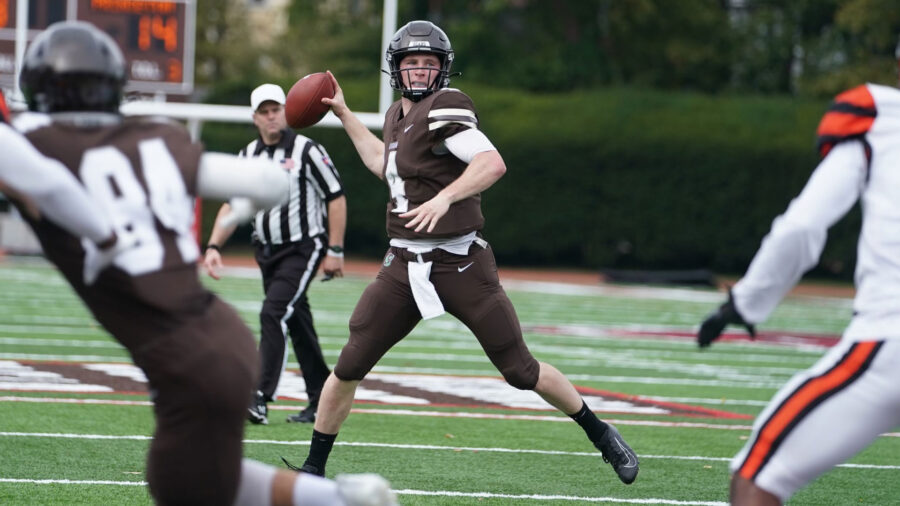
Height: 6’2”. Weight: 208 lbs. Arm: 32”. Hand: 9”.
Pros: A transfer from Boston College, Perry has been a productive if at times erratic starter after finding playing time with the Brown Bears in the Ivy League. In the past two seasons, Perry has accounted for 60 total touchdowns, including 15 rushing scores. A good athlete with a sturdy build, the small school QB demonstrates tools and traits potentially worth developing at the next level. The mobility to extend plays is particularly intriguing to work with.
The potential to be drafted has been greatly aided by good exposure over the pre-draft process. Perry was a relative surprise name added to the East-West Shrine roster with most unfamiliar with the Ivy League prospect. Perry reportedly showed good progress through practices at the event, before throwing three touchdowns to end the week as the game MVP. That was followed by an appearance at the Scouting Combine. His athletic testing reflected the mobility shown on film.
Among his numbers, a rapid 6.85 three-cone time was indicative of the elusiveness he can show on scrambles. Perry flashes the ability to escape pressure, leaving the pocket and attempting to find solutions to broken play situations. He has the potential to offer a backup plan in such scenarios to tuck the ball and run. Perry shows enough zip in his passes to execute with timing. Though not featuring a huge arm, his film includes some impressive downfield highlight completions.
There is a lot to like about Perry’s competitive intangibles. By all accounts, the Bears quarterback is driven to win and succeed. He provides energy and belief to his teammates that appeared to carry over to Shrine week, despite the step up in competition. The reported opinions suggest he has promising football intelligence while being committed to film room work.
Cons: While receiving praise for his Shrine game performance, some easy completions and YAC aided the statistical output. Other passes included throwing behind his target on a slant and sailing the ball on a couple of overthrows among his inconsistent ball placement. At Brown, Perry’s film is rife with ugly decision-making, turnovers, forcing of the ball, and poor recognition of coverage. There was an unquestioned lack of talent around him on offense to assist. Many of the forced throws come with the caveat of being somewhat sympathetic to the lack of help available to him.
Even with some context, the struggles with turnovers included 27 over the past two seasons. The protection wasn’t great but there is still concern with the overall pocket presences and poise. Highly erratic decision making under pressure is joined by inefficient footwork, despite the escape quickness. While Perry is able to leave the pocket, the accuracy throwing on the run can be poor. His coordination and overall footwork factor into the inconsistency.
Perry’s throwing mechanics wouldn’t be described as particularly compact and though he can flash timing and touch, he features modest overall arm strength. There is disconnect between his upper and lower body as he steps into his throws. Though he can drive the ball downfield, he requires extra torque to generate enough velocity that can affect his downfield accuracy at times. While he shows some positive mental aspects competitively, Perry doesn’t often progress beyond the first read, though in fairness, his O-line didn’t always give ideal protection and time.
Wrapping Up: Perry has enjoyed a profile-raising pre-draft process that saw him take advantage of the exposure of attending the Shrine Bowl and Combine. After progressing through the week, the Boston College transfer was named MVP of the week-ending game. The Ivy League prospect is an intelligent and mentally tough competitor that contrasts with frustratingly inconsistent film. Hindered in part by a less-than-ideal lack of help around him on offense, the attempts to compensate can lead to some ugly turnovers. Work ethic and mobility contribute to the interest, yet there is a lot to clean up and questions over the ceiling, regardless. Positional value and athletic potential could lead to a draft round selection, but personally have too many concerns to buy into the projection.

